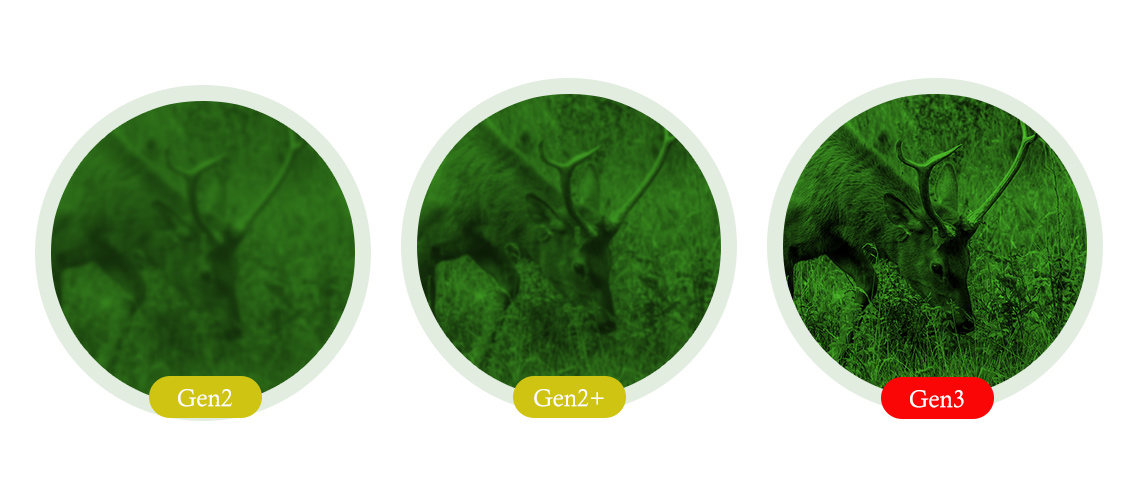December 10,2024By:Innova OpticsView:574
Performance
Gain level
The second-generation image intensifier tube (Gen2/Gen2+): The gain is generally around 2000-4000 times. This enables it to effectively amplify weak light signals, allowing users to see the general outline and details of the target object in a darker environment.
The third-generation image intensifier tube (Gen3): has a higher gain, usually between 30000-50000 times. Such a high gain allows it to present a relatively clear and bright image in extremely dark environments, such as very weak moonlight or starlight environments, and it is more efficient in the use of light.
Resolution
Gen2/Gen2+: The resolution is relatively low, and its center resolution may be around 36-45lp/mm (line pairs/millimeter). This means that when observing distant objects, the details may be blurred, especially for some small targets or fine parts of objects, which may be difficult to distinguish clearly.
Gen3: The resolution has been significantly improved, and the center resolution can reach around 64-72lp/mm. This allows it to provide clearer details when observing targets, such as better performance in identifying the texture of distant targets and small logos.
Signal-to-noise ratio
Gen2/Gen2+: The signal-to-noise ratio is relatively low, usually around 12-14. A low signal-to-noise ratio will result in more noise in the image. In low-light environments, these noises may interfere with the observation of the target and reduce the image quality.
Gen3: It has a higher signal-to-noise ratio, generally between 18-22. High signal-to-noise ratio makes the image clearer and cleaner. Even when the image is magnified to observe details or in low light conditions, it can effectively reduce the impact of noise on observation and provide a more realistic and reliable image.
Differences in technical principles
Second-generation image intensifier tube (Gen2/Gen2+): mainly based on microchannel plate (MCP) technology. When photons hit the photocathode, the emitted photoelectrons are accelerated to the microchannel plate under the action of the electric field. There are a large number of tiny channels in the microchannel plate. After multiple collisions and multiplications in the channel, the electrons form an enhanced electron flow, and finally hit the fluorescent screen to form a visible image. This technology improves the magnification of light to a certain extent, but there are also some limitations, such as the channel of the microchannel plate is prone to blockage and other situations that affect performance.
Third-generation image intensifier tube (Gen3): uses more advanced gallium arsenide (GaAs) photocathode technology. Gallium arsenide photocathode has higher quantum efficiency and can more effectively convert photons into photoelectrons. At the same time, combined with the improved microchannel plate and electron optical system, the transmission and multiplication process of photoelectrons is more efficient, thereby improving the image quality and overall performance.

Differences in price and application scenarios
Price
Second-generation image intensifier tube (Gen2/Gen2+): Due to its relatively mature technology and low manufacturing cost, the price is relatively cheap. Generally, the price of night vision devices equipped with second-generation image intensifier tubes is around several thousand yuan, which is suitable for some civilian fields that do not require particularly high night vision functions, such as ordinary outdoor observation, security patrol and other scenes.
Third-generation image intensifier tube (Gen3): Because it uses more advanced technology, the R&D and manufacturing costs are higher, and the price is also more expensive. The price of night vision devices equipped with third-generation image intensifier tubes is usually tens of thousands of yuan or even higher. It is mainly used in military, high-end law enforcement, special operations and other fields with extremely high requirements for night vision performance, such as military reconnaissance, special forces night operations, etc.
Application scenarios
Second-generation image intensifier tube (Gen2/Gen2+): Suitable for night environments with slightly better light conditions, such as urban suburbs, scenes with a certain amount of moonlight or artificial light sources. It can be used for some general night surveillance, wildlife observation and other activities.
The third generation image intensifier tube (Gen3): can be used in more severe lighting conditions, such as deep in the mountains and forests, and in the wild environment without moonlight. It is widely used in night operations in military operations, anti-terrorism special operations, and some scientific research that requires high-precision observation in extremely dark environments.
Go Top